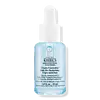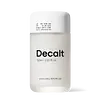What's inside
What's inside
 Key Ingredients
Key Ingredients

 Benefits
Benefits

 Concerns
Concerns

 Ingredients Side-by-side
Ingredients Side-by-side

Water
Skin ConditioningPentylene Glycol
Skin ConditioningGlycerin
HumectantGlycolic Acid
BufferingGluconolactone
Skin ConditioningCentaurea Cyanus Flower Water
Skin ConditioningPropanediol
SolventLactic Acid
BufferingSodium Hydroxide
BufferingPanthenol
Skin ConditioningAllantoin
Skin ConditioningSalicylic Acid
MaskingTrisodium Ethylenediamine Disuccinate
Hydroxyethylcellulose
Emulsion StabilisingCopper Gluconate
Skin ConditioningCoco-Betaine
CleansingCarica Papaya Fruit Extract
Skin ConditioningCitric Acid
BufferingPotassium Sorbate
PreservativeArginine
MaskingDisodium Phosphate
BufferingPolysorbate 60
EmulsifyingSodium Phosphate
BufferingWater, Pentylene Glycol, Glycerin, Glycolic Acid, Gluconolactone, Centaurea Cyanus Flower Water, Propanediol, Lactic Acid, Sodium Hydroxide, Panthenol, Allantoin, Salicylic Acid, Trisodium Ethylenediamine Disuccinate, Hydroxyethylcellulose, Copper Gluconate, Coco-Betaine, Carica Papaya Fruit Extract, Citric Acid, Potassium Sorbate, Arginine, Disodium Phosphate, Polysorbate 60, Sodium Phosphate
Water
Skin ConditioningPropanediol
SolventGluconolactone
Skin ConditioningGlycerin
HumectantButylene Glycol
Humectant1,2-Hexanediol
Skin ConditioningArginine
MaskingHydrogenated Lecithin
EmulsifyingCaprylic/Capric Triglyceride
MaskingPotassium Cetyl Phosphate
EmulsifyingSimmondsia Chinensis Seed Oil
EmollientSalicylic Acid
MaskingHydroxyacetophenone
AntioxidantAllantoin
Skin ConditioningDipotassium Glycyrrhizate
HumectantSqualane
EmollientVolcanic Ash Extract
Skin ConditioningTrehalose
HumectantHydroxyethylcellulose
Emulsion StabilisingSea Water
HumectantArtemisia Princeps Leaf Extract
Skin ConditioningSodium Hyaluronate
HumectantJuniperus Mexicana Oil
MaskingRosmarinus Officinalis Leaf Oil
MaskingAmyris Balsamifera Bark Oil
MaskingAnthemis Nobilis Flower Oil
MaskingEthyl Hexanediol
SolventWater, Propanediol, Gluconolactone, Glycerin, Butylene Glycol, 1,2-Hexanediol, Arginine, Hydrogenated Lecithin, Caprylic/Capric Triglyceride, Potassium Cetyl Phosphate, Simmondsia Chinensis Seed Oil, Salicylic Acid, Hydroxyacetophenone, Allantoin, Dipotassium Glycyrrhizate, Squalane, Volcanic Ash Extract, Trehalose, Hydroxyethylcellulose, Sea Water, Artemisia Princeps Leaf Extract, Sodium Hyaluronate, Juniperus Mexicana Oil, Rosmarinus Officinalis Leaf Oil, Amyris Balsamifera Bark Oil, Anthemis Nobilis Flower Oil, Ethyl Hexanediol
 Reviews
Reviews

Ingredients Explained
These ingredients are found in both products.
Ingredients higher up in an ingredient list are typically present in a larger amount.
Allantoin is a soothing ingredient known for its protective and moisturizingg properties. Because of this, it is often added to products with strong active ingredients.
Studies show higher concentrations of this ingredient can promote wound healing.
Though it can be derived from the comfrey plant, allantoin is produced synthetically for cosmetic products to ensure purity.
Learn more about AllantoinArginine is an amino acid that is important for human development. Your body uses is it to produce hair keratin and skin collagen.
As a cosmetic ingredient, Arginine has antioxidant properties and can also help repair damaged skin. This ingredient is derived either synthetically or from animals.
Arginine isn't fungal acne safe when used in the presence of other lipids (fats, fatty acids, oils, esters, etc). Oils and fats occur naturally within the skin, so take caution when using Arginine if you're prone to fungal acne.
Learn more about ArginineGluconolactone is a PHA. PHAs are a great gentle alternative to traditional AHAs.
When applied, Gluconolactone has the same affect on skin as AHAs such as lactic acid. It helps dissolve the dead skin cells in the top layer of your skin. This improves texture and brightens the skin.
PHAs are more gentle than AHAs due to their larger structure. They do not penetrate as deeply as AHAs and take a longer time to dissolve dead cells. Studies show PHAs do not cause as much irritation.
Gluconolactone has some interesting properties:
In a 2004 study, Gluconolactone was found to prevent UV damage in mouse skin cells and has not been found to increase sun sensitivity. However, we still recommend wearing SPF daily.
This ingredient is is an created by reacting gluconic acid with an alcohol.
Learn more about GluconolactoneGlycerin is already naturally found in your skin. It helps moisturize and protect your skin.
A study from 2016 found glycerin to be more effective as a humectant than AHAs and hyaluronic acid.
As a humectant, it helps the skin stay hydrated by pulling moisture to your skin. The low molecular weight of glycerin allows it to pull moisture into the deeper layers of your skin.
Hydrated skin improves your skin barrier; Your skin barrier helps protect against irritants and bacteria.
Glycerin has also been found to have antimicrobial and antiviral properties. Due to these properties, glycerin is often used in wound and burn treatments.
In cosmetics, glycerin is usually derived from plants such as soybean or palm. However, it can also be sourced from animals, such as tallow or animal fat.
This ingredient is organic, colorless, odorless, and non-toxic.
Glycerin is the name for this ingredient in American English. British English uses Glycerol/Glycerine.
Learn more about GlycerinHydroxyethylcellulose is used to improve the texture of products. It is created from a chemical reaction involving ethylene oxide and alkali-cellulose. Cellulose is a sugar found in plant cell walls and help give plants structure.
This ingredient helps stabilize products by preventing ingredients from separating. It can also help thicken the texture of a product.
This ingredient can also be found in pill medicines to help our bodies digest other ingredients.
Learn more about HydroxyethylcellulosePropanediol is an all-star ingredient. It softens, hydrates, and smooths the skin.
It’s often used to:
Propanediol is not likely to cause sensitivity and considered safe to use. It is derived from corn or petroleum with a clear color and no scent.
Learn more about PropanediolSalicylic Acid (also known as beta hydroxy acid or BHA) is a well-known ingredient for treating skin that struggles with acne and clogged pores. It exfoliates both the skin's surface and deep within the pores to help clear out buildup, control oil, and reduce inflammation.
Unlike AHAs (alpha hydroxy acids), salicylic acid is oil-soluble. This allows it to penetrate into pores which makes it especially effective for treating blackheads and preventing future breakouts.
Salicylic acid is also known for its soothing properties. It has a similar structure to aspirin and can calm inflamed or irritated skin, making it a good option for acne-prone skin that is also sensitive.
Concentrations of 0.5-2% are recognized by the U.S. FDA as an over-the-counter topical acne product.
It can cause irritation and/or dryness if one's skin already has a compromised moisture barrier, so it's best to focus on repairing that before introducing this ingredient into your routine.
While salicylic acid does not increase sun sensitivity, it’s still important to wear sunscreen daily to protect your skin.
If you are looking for the ingredient called BHA or Butylated Hydroxyanisole, click here.
Learn more about Salicylic AcidWater. It's the most common cosmetic ingredient of all. You'll usually see it at the top of ingredient lists, meaning that it makes up the largest part of the product.
So why is it so popular? Water most often acts as a solvent - this means that it helps dissolve other ingredients into the formulation.
You'll also recognize water as that liquid we all need to stay alive. If you see this, drink a glass of water. Stay hydrated!
Learn more about Water